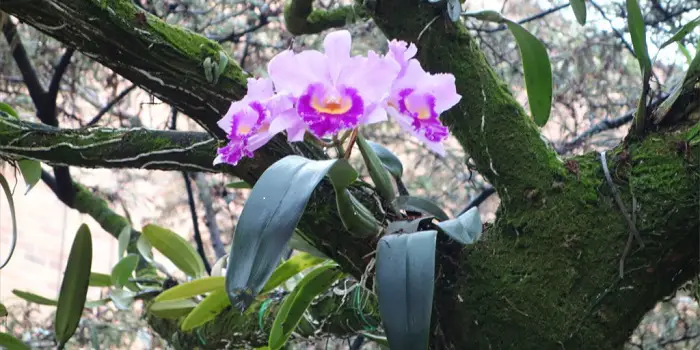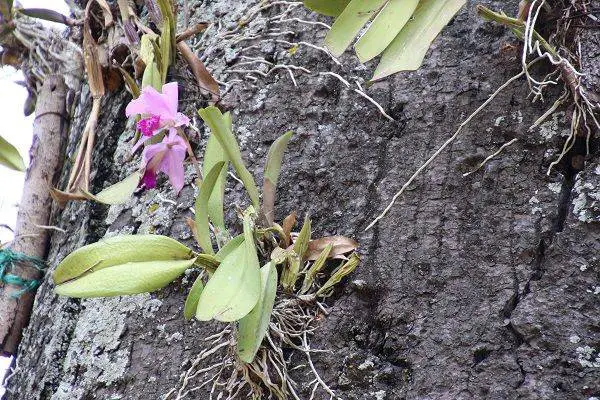Novice flower growers, not understanding the situation and structure of the orchid, believe that this plant is a parasite, but this is not so. She simply lives on tree trunks and is an epiphytic plant.
Next, we will try to give a detailed answer to the question of whether orchids are parasites or not, so much of interest to many.

are orchids parasites or epiphytes?
Some growers believe that orchid plants are parasites that live on other plants. But this is not so, plants, attaching to trees, do not parasitize, extracting food from the tree trunk.
The tree serves them as an object that helps them get closer to the sunlight. And the plant receives nutrition from the air saturated with moisture.
Orchids do not parasitize trees but use them as support.
The root mass of the orchid is arranged in such a way that the plant can attach well to the trunk of the tree, or rather, to its bark. The conductive root shaft conducts moisture throughout the flower bush, while velamen provides moisture delivery to the conductive root.
what is epiphytic plants?
These tropical epiphytic plants used to be cultivated only in greenhouses, but now they can often be seen in our homes. And in order for them to grow successfully, you need to familiarize yourself with the concept of what an epiphyte is, in order to choose the right living conditions for a plant in an apartment.
Translated from Greek, it sounds like “a plant living on another plant .” That is, epiphytic orchids can germinate on the trunks and lower branches of their taller counterparts – trees.
Epiphytic plants are common in tropical forests, where tall trees, growing up, are connected by crowns and under them, it is very gloomy due to lack of sunlight, so the plants rise closer to the light source, climbing tree trunks.
what is epiphytic orchids?
The epiphytic orchid is arranged like all other plants. Orchid has available:
- trunk;
- leaves;
- roots.
The roots have a special structure because with their help it is attached to the tree trunk. The first layer of the root is velamen, which absorbs moisture like a sponge. Then there is a conductive root inside that delivers moisture to the trunk of the plant. And from there, moisture enters the leaf plates, which are green and they are quite elastic, with a smooth structure of the leaf surface.
IMPORTANT! Healthy leaves have turgor and luster.
See also Do Orchids Have Pollen Allergy?
What is the natural habitat for orchids?
At home, the orchid exists in places where:
- a lot of sunlight scattered light;
- a lot of humidity, especially during the rainy season;
- the air temperature practically does not deviate from the range of 23-27 degrees Celsius.
Therefore, she has enough light, and she takes moisture from the frequent rains. The air is simply saturated with moisture and never completely dries up.
Since even if the rain stops for a while, then wet evaporation comes from the ground and it lasts long enough, since the crown, closing at the top, does not allow moisture to quickly evaporate from the surface of the earth.
With the help of its root system, arranged in a special way, the plant feeds on moist air. And it takes nutrients from the bark, where rotted leaves can be in a thin layer. This is enough for her for good development and full flowering.
It has already been proven that orchids are not parasitic flowers and use other plants or objects only to be closer to the sun’s rays, towering over other herbaceous plants located in the lower tier of the rainforest.
Orchids have adapted to live in different places except for Antarctica, and have divided into different groups according to the way they choose their place of residence.

orchids live and grow on tree trunks
Epiphytic orchids are located on trees, both living and dead, climbing over them with their root mass. They do not live off older plants, but simply attach to them.
Orchid on a tree.
The root system of orchid plants absorbs water well directly from the air. The flower can find nutrients in depressions or in the hollows of trees, where humus soil accumulates, even a thin layer is enough.
Here is the answer to the question How often do Phalaenopsis Orchids Bloom?
Orchid live On old stumps, hollows, cracks
Old stumps, hollows, and cracks are rich in leaves that have already partially rotted and therefore are able to feed the plant well.
The only condition is that in such recesses there are holes through which excess water will drain after frequent tropical rains. Since stagnant water, turning into swamps will simply destroy the flower.
Orchid live On rocks and stones
Lithophytic orchid plants are located on the stones. They are usually found in the mountains at an altitude of 2 km. above sea level, located just on the sheer cliffs.
Lithophytic orchids grow on rocks.
There is a lot of suns, but it no longer hurts the flowers, since the temperature is noticeably lower than below in the rainforest, where, among other things, there is also a greenhouse effect.
Orchid live On ground
There are also many orchid plants on the ground, they grow in width, capturing the territory under their pseudobulbs. They have a slightly different root system, it looks more like an ordinary one, like other plants. Because it grows in soil, where, in addition to bark and moss, you can find ordinary turf soil.
IMPORTANT! When purchasing an orchid for yourself, you need to know what species it belongs to. This is necessary in order to properly organize the care of it and correctly select the substrate.
You want to know about Rare Orchid Flowers Plant.
are orchid donors or vampires?
Let’s try to soberly assess whether this flower can be a vampire or not.
Some growers, whose orchid died due to improper care, begin to blame the flower for negative energy. Instead, it will be better to take a closer look at the rules of care and avoid future plant problems.
The orchid is by no means a vampire. She is not able to draw energy from a person with her beautiful tropical flowering. Such myths could exist in ancient times when people experienced fear of everything that was very different from their constant environment.
Rather, the flower can be considered a donor, since it gives people its beauty during the flowering period. And without beautiful flowers, it is practically indistinguishable from other plants.
Flower energy for home
Superstitious people believe that a flower is akin to a vampire in its beauty. They themselves support this myth, telling how they are enchanted by a flower.
Blossoming, the flower decorates the house with its flower shoots, making it more comfortable. After all, a small number of bowls with orchids will be a wonderful decoration for any living room.
The only thing that can harm, if the florist is the core, and there are too many flowers, then at night they will absorb a lot of oxygen, and then this will affect the heart. In this case, the person must sleep separately from their collection of gorgeous flowers.
Do orchids take good energy from person?
Indecisive and apathetic people believe that the orchid takes energy from a person, feeding on their strength. But from the point of view of science, this is complete nonsense. Because plants cannot pull human energy. Just apathetic people, in order to justify their negative coloring to everything that moves and lives, refer to a beautiful flower that is not to blame for anything.
Orchids do not take away energy but give joy with their flowering.
Do orchid affect mood?
Well, how can beautiful tropical flowers influence the mood of a florist? Especially if he waited for this flowering for many months and took care of his flower.
When the first bud dissolves, the mood will be in the stage of delight, because at the sight of this beauty, the mood rises, and all the negative fades into the background.
Conclusion
A blooming orchid will adorn any interior. It raises the mood of a person and decorates his life. All efforts to care for a tropical plant will pay off at the time of its flowering.
